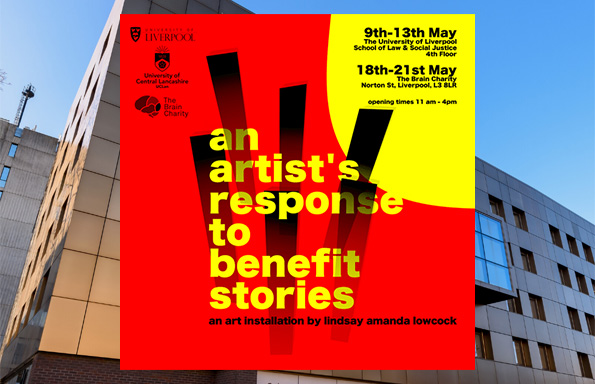
The Department of Sociology, Social Policy and Criminology and the Publics and Practice Research Cluster member Louise Hardwick and Collaborators are proud to host:
An artistic response to benefit stories.
Monday 9th May – Friday 13th May, 11:00 – 4:00pm each day
School of Law & Social Justice, 4th floor, PGR Suite 5.
By the artist Lindsay Lowcock in collaboration with Louise Hardwick (SSPC , University of Liverpool), Aidan Worsley (Uclan), and The Brain Charity.
This installation is part of a wider dissemination strategy to report on the findings from the study seeking recognition for people with severe disabilities on benefits.
Voice is an important part of inclusion in life: being recognised; taking part; being heard. The participants in the study were given a rare opportunity to vocalise their experience, and, in response, the artist Lindsay Lowcock has designed an installation to display their voices.
This will be achieved by the voices of the participants becoming vocal performances that will be heard through six monolithic speakers. Each performance will consist of one word taken from the study which distils their experience of depending on disability benefits.
Like the standing stones of death monuments, the speakers will create a space for the viewer- experiencer to wander around and hear the individual voices. The combined audio and physical interactional experience will create an oppressive, confining, baffling, and demoralising response, akin to that experienced by study participants.
Beyond the field of sound, a light is to be situated: a tall and thin slit of simulated sunlight. This represents Judith Butler’s (2016) concept of recognition. In contrast, in the field of sound, the vocal performances and the people they represent occupy a hinterland not comprehended to the unimpaired, and in that hinterland they remain unrecognised.
Louise Hardwick, Senior Lecturer, comments:
"This art installation disseminates findings from the study ‘seeking recognition for people with severe disabilities on benefits.’ Both the study and installation are the outcome of partnership that aims to give a rare voice to people with severe disabilities, and help create collective stories of how this group’s experiences are shaped by systemic violence."
Lindsay Amanda Lowcock comments:
"This is a challenging look at social inclusion, poverty and disability. Designed to inspire empathy towards disadvantage."